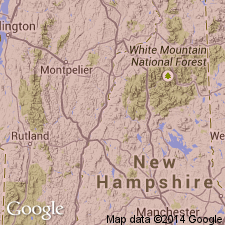
- Usage in publication:
-
- Biddie Knob formation
- Modifications:
-
- Areal extent
- Dominant lithology:
-
- Slate
- AAPG geologic province:
-
- New England province
Summary:
Revised stratigraphic sequence proposed for north end of slate belt, Taconic Range. Consists of three major units: basal purple and green chloritoid slate (Biddie Knob formation); an intermediate Bull formation; and a black slate formation (the Hooker). Fossils in Bull and Hooker formations indicate that bulk of section is early Cambrian.
[Type locality and origin of name not stated.]
Source: US geologic names lexicon (USGS Bull. 1200, p. 325).

- Usage in publication:
-
- Biddie Knob formation
- Modifications:
-
- Areal extent
- AAPG geologic province:
-
- New England province
Summary:
Pg. 1. Biddie Knob formation. Underlies Mettawee member of Bull formation. [Age is Early Cambrian.]
[Type locality and origin of name not stated.]
Source: US geologic names lexicon (USGS Bull. 1200, p. 325).

- Usage in publication:
-
- Biddie Knob Formation*
- Modifications:
-
- Overview
- AAPG geologic province:
-
- New England province
Summary:
Pg. 19-20. Biddie Knob Formation. Purple and green, chloritoid-bearing slate and phyllite, and subsidiary quartzite and rare thin limestone. Age is considered Cambrian(?).
Type locality: west and south slopes of Biddie Knob, town of Pittsford, approx. Lat. 43 deg. 42 min. 45 sec. N., Long. 73 deg. 06 min. 30 sec. W., Proctor 7.5-min quadrangle, Rutland Co., Taconic Range, central western VT.
Principal reference: E-an Zen, 1961, GSA Bull., v. 72, p. 299.
Source: Publication.

- Usage in publication:
-
- Biddie Knob Formation*
- Modifications:
-
- Mapped
- AAPG geologic province:
-
- New England province
Summary:
Biddie Knob Formation. Predominantly green, purple and purplish-red, chloritic hematitic slate and phyllite, massive to thinly bedded. Has rare thin beds of white vitreous quartzite and contains abundant chloritoid. Underlies the Bird Mountain Grit (of Dale, 1900) and grades into the green slate of the Mettawee slate facies in the Bull Formation, probably in part correlative with the green phyllite member of the Netop Formation of the Dorset Mountain slice. Age is Neoproterozoic and Early Cambrian.
Source: Publication.
For more information, please contact Nancy Stamm, Geologic Names Committee Secretary.
Asterisk (*) indicates published by U.S. Geological Survey authors.
"No current usage" (†) implies that a name has been abandoned or has fallen into disuse. Former usage and, if known, replacement name given in parentheses ( ).
Slash (/) indicates name conflicts with nomenclatural guidelines (CSN, 1933; ACSN, 1961, 1970; NACSN, 1983, 2005, 2021). May be explained within brackets ([ ]).

